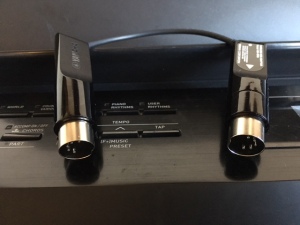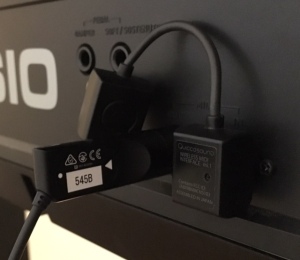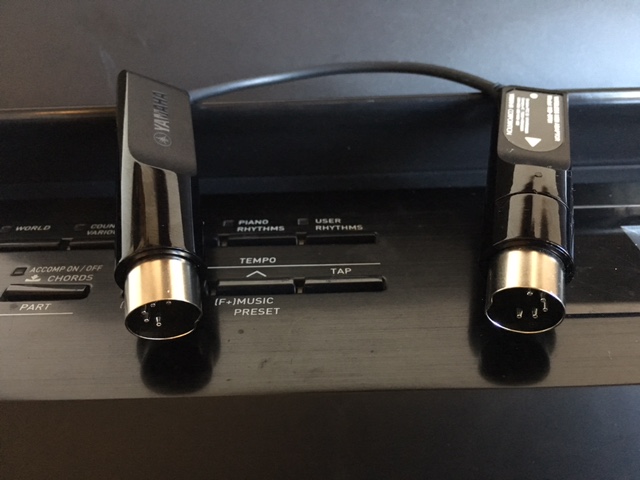
Yesterday morning, a package from Yamaha arrived. That package contained the MD-BT01 Bluetooth MIDI Adapter, the sister product to the UD-BT01 that I reviewed a couple of weeks ago.
As I write this post this morning, I think there are four questions that should be asked:
- Why am I writing about BLE MIDI? Why is it important?
- Why did Yamaha make both the MD and UD versions of this device?
- Does the MD-BT01 Work?
- Should I buy it?
So let’s take a look at those questions, not necessarily in that order.
As for BLE MIDI (Bluetooth Low Energy MIDI), I consider it a format that revolutionizes MIDI interaction with computers (or mobile devices). I have nothing against MIDI, and I think it is a pretty remarkable standard. Think about it: MIDI 1.0 was released in 1983, which is over 30 years ago. Look around your house or office and ask yourself this: what item of technology is still using the same basic standard that it has used for thirty years?
That said, interaction with software and MIDI was always complicated for me. We have MIDI do things it was never really intended to do (which again, is quite amazing) but dealing with MIDI settings and software can be tricky.
BLE MIDI does two things. First, it simplifies the MIDI connection process (particularly on iOS Devices). Second, it removes wires. Both of these things makes my life better as a singer, player, arranger, composer, and teacher. It is the single advancement in the past five years (after the iPad) that has real impact on my life.
Meanwhile, there are only a handful of companies doing anything with BLE MIDI. I reach out to those companies and ask to test products. On most occasions, companies wish to get the word out. On some occasions, I am nicely told to “take a hike” (most recently by a company that rhymes with “Borg.”) I am grateful for the many companies, in this case, Yamaha, that sends a product that I can test.
Back at Winter NAMM (January), Yamaha introduced two new Wireless MIDI Adapters. One was the UD-BT01 and the other was the MD-BT01. These both sell in the $50 range and enable a keyboard without BLE MIDI to have it. The UD-BT01 is a USB adapter, allowing a keyboard with USB MIDI to plug into the adapter (which itself plugs into a power adapter). The MD-BT01 (the subject of this review) simply plugs into the MIDI ports on the back of a keyboard.
The MD-BT01 functions in a way that is similar to an older product, the Quicco Sound mi.1. The mi.1 features shorter ports, but each plug is square, whereas the Yamaha MD-BT01 is the same size as a regular MIDI cable. The mi.1 has three flaws at the moment: it cannot connect to the CME WIDI Bud, the square part can conflict with the back of some keyboards (some do not have clearance around the MIDI ports), and it requires a MIDI port that has a powered pin. The Yamaha MD-BT01 only has one of these flaws, which is that it also depends on power from a MIDI port with a powered pin. Some keyboards (particularly those that are older) do not have a powered pin, and therefore the MD-BT01 (or the mi.1) will not work for those keyboards. I also like that the MD-BT01 has a little more cable between the two sides of the adapter than the mi.1. This just offers a little more flexibility when working with the device.

I had thought that the longer length of the MD-BT01 (versus the mi.1) could have been a problem when your keyboard was against a wall, so I compared the MD-BT01 to a regular MIDI cable. It turns out that the MD-BT01 isn’t much longer (half an inch) than a regular MIDI cable, so those fears were unwarranted.

The MD-BT01 is also labeled on each plug, having an arrow to show which side goes to MIDI IN, and which goes to MIDI out. Plug it in, turn on the power, and you are ready to connect with your device (as long as your device is BLE MIDI enabled).

As expected, the MD-BT01 connects easily to the iPad (remember, you have to connect using a program that connects to the BLE MIDI device, such as GarageBand). It can also interact with more recent (2012) MacBooks, and nearly any other device via the CME WIDI Bud. I was finally able to get my old Windows device (Asus T-100) to connect to BLE MIDI devices with the WIDI Bud (I needed to use Notion to do it). That said, it is time to give that old Asus away, as it cannot handle 64-bit programs (like Finale).
As another tip, George Litterst let me know that there is a program to update the firmware of both the MD-BT01 and the UD-BT01. You can find that app (iOS) here. It is an iPhone app, but it does run on iPads, too. One of the great things about this app is that you can rename the device (if you were going to be running multiple BLE adapters, which is possible). However, you have to re-rename the device every time you update the firmware (the firmware restores the original name). Incidentally, George created a iOS MIDI guide for TimeWarp, which may be of interest to you.

Now: the big question: do you need one of these?
If you have an older keyboard without BLE MIDI (which represents most keyboards), I think there is significant reasons to add that capability. Right now there are four ways to add BLE MIDI to an older keyboard: The mi.1, the UD-BT01, the MD-BT01, and the Zivix PUC+.
I can’t really recommend the mi.1. At one point, it was less expensive than other options, but that really isn’t true any longer. The device is in its third revision, but in my tests I could not get the mi.1 to connect to the CME WIDI Bud (although it does connect to my iOS devices). Even though it is in its third revision, it still has the same design and flaws as I mentioned earlier in the article.
The MD-BT01 (the focus of this review) is something I can recommend. Its form factor is the similar to the mi.1, but different enough that port clearance is never an issue. It comes from a well-respected manufacturer, and is priced fairly. It works with the WIDI Bud, which mean that you can make a Chromebook, old MacBook, or Windows computer into a BLE enabled device. The only time the MD-BT01 might not work for you is if your keyboard lacks a powered MIDI port. In that case, see the Zivix PUC+.
The UD-BT01 is basically the same device as the MD-BT01, but requires a USB connection and a power adapter. If your keyboard is new enough to have a USB MIDI connection, it likely also has a powered MIDI port, so honestly, I don’t see why you would choose the UD over the MD. That said, I do have a couple of keyboards that only have a USB port (such as my Akai LPK-25, which is still available) that requires external power, and the UD-BT01 can work with that device. Like the MD-BT01, the UD-BT01 works with the WIDI Bud. It is also priced in the $50 range.

The Zivix PUC+ is a BLE wireless MIDI Adapter that has its own power source (AA batteries), a single MIDI port, and USB connectivity. The positive thing about the PUC+ is that it pretty much works with anything you throw at it, as it provides its own power and is unleashed from wall plugs. In terms of negatives, it uses batteries and only has a single traditional MIDI port. It sells for $99. If your keyboard has MIDI without a powered port or USB MIDI, this is the solution for you.
Don’t you love that we have all of these options today? All four options work with iOS.
And again, don’t forget the WIDI Bud, the small USB adapter that turns most non-BLE devices into BLE capable devices (including old iPads, but the iPad USB camera connection kit would be required). It really works (and is also $50)!

Let’s say you have an old MacBook and an “old” Keyboard (with USB). For $100, you can add BLE capability to your setup without having to buy a new MacBook and keyboard. In the short run, that saves you $1700 ($1200 MacBook, $600 keyboard).
Back to the topic at hand: the MD-BT01. Yamaha has made an attractive and pragmatic wireless MIDI adapter that can be attached to your existing keyboard through its MIDI ports to turn your old keyboard into a BLE MIDI Keyboard. As long as your keyboard is new enough to have a powered MIDI pin in its MIDI port, this is a great device to purchase.
